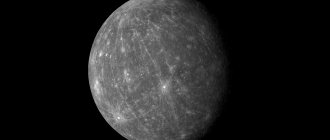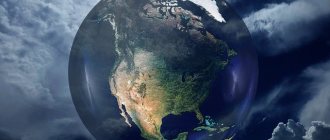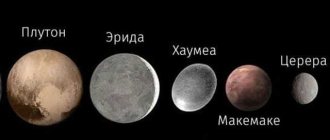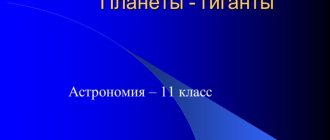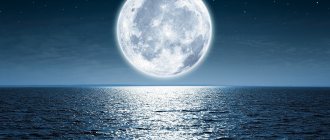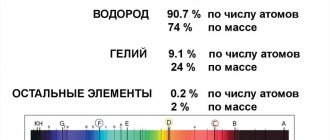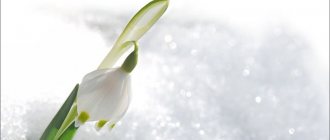check yourself
1) Name the planets according to the diagram on this page. For self-test, use the diagram on p. 5.
On the left we see the Sun. From it we name the planets: Mercury, Venus, Earth and its satellite Moon, Mars, Jupiter, Saturn, Uranus and Neptune.
2) Briefly tell us about the planets of the solar system.
A short story about the planets of the solar system for grade 4
The smallest planet in the Solar System is Mercury. It is closest to the Sun. The planet farthest from the Sun is Neptune, and the largest planet is Jupiter.
Four planets have rings: Saturn, Jupiter, Uranus and Neptune. These planets are called giant planets, and each has many natural satellites. The Earth also has a natural satellite, the Moon, and Mars has two such satellites, but they are very small. And Venus and Mercury are devoid of satellites.
3) How does the Earth move in outer space?
In outer space, the Earth rotates on its axis, but it also revolves around the sun.
4) Explain why the change of day and night occurs on Earth.
The change of day and night occurs due to the rotation of the Earth around its axis. On the surface of the Earth illuminated by the Sun it is day, on the dark side it is night.
5) Why do seasons change on our planet?
The change of seasons occurs due to the rotation of the Earth around the Sun and the tilt of the Earth's axis. The Earth exposes the sun to the Southern and Northern hemispheres, and on the hemisphere that is closer to the sun it is summer.
Planets of the solar system presentation for a lesson on the world around us (grade 4) on the topic
Slide 2
Work in pairs What planets are part of the solar system? In what order are they located as they move away from the Sun? MERCURY IN ENERA EARTH MARS JUPITER SATURN URANUS NEPTUNE
Slide 3
Most planets can be seen from Earth with the naked eye. They look like bright stars. But we must remember that planets, unlike stars, do not emit their own light. They only reflect the light of the Sun.
Slide 4
Mercury This is the planet closest to the Sun. It got its name in honor of the Roman god of trade. This is the fastest planet. Orbits the Sun in 88 days. Mercury is hot during the day and icy cold at night. The surface of the planet is rocky and desert.
Slide 5
Venus The second planet from the Sun. Bears the name of the goddess of beauty. It looks like a very bright star, it is also called the “morning star”. The planet may shine with a silvery light, very similar to Earth. Venus is surrounded by a thick layer of clouds. Under the cloud cover the heat is unbearable. In the atmosphere of Venus, lightning strikes more often than on Earth by 2 orders of magnitude. Thousands of ancient volcanoes, hundreds of craters, and mountains have been discovered on it.
Slide 6
Earth This is the third planet from the Sun. Formed about 4.5 billion years ago. It is called the “Blue Planet” because it has a lot of water and it has an air shell, an atmosphere, which gives the planet its blue color. The earth consists of stone and metals and has a complex structure.
Slide 7
Mars The fourth planet from the Sun is named after the Roman god of war for its red color. The surface of Mars contains a large amount of iron, which, when oxidized, gives a red color. At night, the temperature on Mars drops to minus 85°.
Slide 8
Jupiter The largest planet in the solar system. Named after the main Roman god Jupiter. Consists mainly of various gases. Powerful hurricanes constantly rage in Jupiter's atmosphere.
Slide 9
Saturn The planet is named after the Roman god of agriculture. It is surrounded by many bright rings, which consist of fragments of ice and stones. Saturn is composed primarily of gases and has no solid surface. Saturn has the strongest winds in the solar system (500 m/s). Easily visible to the naked eye from Earth.
Slide 10
Uranus This giant planet is named after the Greek god of the sky, Uranus. The interior of Uranus consists mainly of ice and rocks. Due to its great distance from the Sun, Uranus receives very little light and heat from it - almost 370 times less than the Earth.
Slide 11
Neptune The planet is named after the Roman god of the seas. It flickers with a bluish light, reminiscent of the shine of water. The temperature on the surface of Neptune is minus 200°C. The planet is experiencing the most powerful storms in the entire solar system.
Slide 12
Change of day and night - rotation of the Earth around its axis (day)
Slide 13
Change of seasons - rotation of the Earth around the Sun (year)
Slide 14
Let's summarize: Name the planets of the solar system? What natural satellite does the Earth have? How does the Earth move in outer space? 4. Why does the change of seasons on Earth and the change of day and night occur?
1) Look at the diagram on p. 5. What can you tell about the planets of the solar system?
Using this diagram, we can compare the size of the planets in the solar system, find out what they look like through a telescope, and determine which planets have rings.
Use the diagram to list the planets:
a) in order of increasing size;
List of planets in order of increasing size:
Mercury, Mars, Venus, Earth, Neptune, Uranus, Saturn, Jupiter.
b) in order of decreasing size.
List of planets in decreasing order of size:
Jupiter, Saturn, Uranus, Neptune, Earth, Venus, Mars, Mercury
